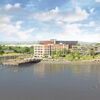Grant supports shellfish industry, public health
The Maine Department of Marine Resources has received a $32,000 grant from the Maine Outdoor Heritage Fund that will allow the department to purchase equipment to test for domoic acid, a naturally occurring biotoxin that can cause serious health risks, including amnesic shellfish poisoning or ASP.
The equipment will be purchased and the DMR staff trained during the upcoming winter months.
While phytoplankton species that cause domoic acid have been detected in Maine waters for years, 2016 was the first year the biotoxin was found in concentrations that could cause adverse health impacts, according to the DMR’s release. Levels of domoic acid detected by the DMR’s biotoxin monitoring program in September triggered closures of harvesting areas for clams and mussels between Bar Harbor and the Canadian border. The event lasted until mid-November, when the final closed area was reopened.
The process of testing for domoic acid involves routine phytoplankton sampling at established sites along the Maine coast throughout the year. The samples are analyzed under a microscope by DMR staff and trained volunteers. If cell counts of the phytoplankton in the water samples reach established levels, a test known as the Scotia Rapid test is conducted to determine if domoic acid is present.
If test results are positive, shellfish in the vicinity are sampled and sent to Bigelow Laboratory for Ocean Sciences for further confirmation using a method known as high-pressure liquid chromatography.
If the concentration of biotoxin in the samples reaches a level established by the U.S. Food and Drug Administration as a baseline for regulatory action — 20 parts per million in the case of domoic acid — the area associated with the toxic shellfish will be closed immediately.
“By transitioning the biotoxin monitoring program to HPLC, DMR is able to respond more effectively to emerging biotoxin threats such as ASP,” said Maine DMR Public Health Bureau Director Kohl Kanwit.
Before HPLC testing was available, the department had no way to test for domoic acid. Instead, notification of possible ASP contamination came to the department from health officials dealing with a potential ASP illness. The FDA then tested samples, which could take up to 10 days, during which large sections of the Maine coast were closed until results were returned.
In 2012, approximately 50,000 acres of shellfish harvest area on the Maine coast were closed as a precaution during the nine days the FDA results were pending. Test results ultimately indicated there were no levels of concern and the areas were reopened.
“HPLC testing by Bigelow Lab was a major improvement for us and for industry,” said Bryant Lewis, the DMR biologist who wrote the grant and will oversee the project.










Comments